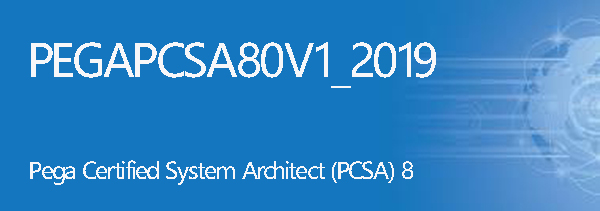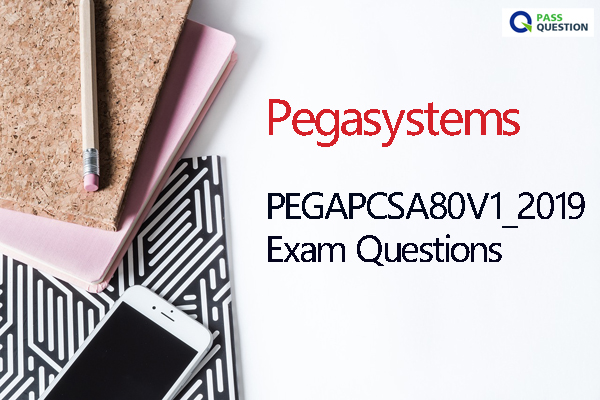PEGAPCSA80V1_2019 Practice Test Questions - Pega Certified System Architect (PCSA) 8
PEGAPCSA80V1_2019 Pega Certified System Architect (PCSA) 8 exam is the new version for System Architect certification, the previous version PEGACSA74V1 is still available until December 31, 2019, you can choose either to get certified. Passquestion provides PEGAPCSA80V1_2019 Practice Test Questions to help you get well prepared and pass your exam successfully in your first time.

Pega Certified System Architect (PCSA) Certification
Pega Certified System Architect certification exam is intended for System Architects and Application Developers who are directly involved in the design and construction of applications built on Pega.
The Pega Certified System Architect (PCSA) Career Path is for developers and technical staff members who want to learn how to develop Pega applications. This certification provides a baseline measurement on your knowledge of Pega Platform. The PCSA Version 8 exam includes scenario questions, multiple choice questions and drag/drop items. If multiple answers are required, the text states how many responses are needed.
PCSA (Pega Certified System Architect) Version 8 Certification Path:
System Architect Essentials (8) course
Exam Code: PEGAPCSA80V1_2019
Type of Exam: 60 question exam
Length: 90 minutes
Passing Grade: 65%
PEGAPCSA80V1_2019 Exam Topics - Pega Certified System Architect (PCSA) 8
Pega Platform (5%)
Case Management (26%)
Data Modeling (20%)
Validation (7%)
Information Exchange (15%)
User Interface (12%)
Application Development (7%)
Reporting (8%)

Free Share Pegasystems PEGAPCSA80V1_2019 Exam Questions To Practice:
1.With Pega’s Situational Layer Cake ™ approach, how do you configure a regional variation for Human Resources (HR) time off cases?
A. Create a rule for the variation and add the rule to the common layer of the application.
B. Create a rule for the variation and replace the existing HR time off rule in the application common layer.
C. Create a rule for the variation and add it to a secondary common application layer.
D. Create a rule for the variation and add the rule to the layer for the region.
Answer: C
2.What are the minimum components of a user interface (UI) action set?
A. Two actions and one event
B. One action, one event, and one condition
C. One action and one event
D. One action and one condition
Answer: D
3.You are designing a form for an online bookstore to display new arrivals. In the form, the book cover pictures are displayed in a row, like words in a sentence. Once the row reaches the full width of the screen, it wraps around to begin a new row.
Which layout do you use to display the book cover pictures?
A. Screen layout
B. Column layout
C. Dynamic layout
D. Repeating layout
Answer: C
4.An online sales application supports both laptop and mobile devices. You are configuring the application skin and you notice the responsive layout in the mobile device & not displaying views as stakeholders require.
Which two options allow you to resolve this situation without negatively impacting the laptop users? (Choose Two)
A. Use the same application skin in all portals.
B. Update the process to give mobile users a separate portal.
C. Adjust the responsive behavior in the skin for optimal viewing in the mobile portal.
D. Do not use a skin for the mobile application version.
Answer: C,D
5.You want your application to have consistent styling across portals. You want the background color of all buttons in your application to be blue. You want the background color of the buttons to be easily updated in case corporate branding changes.
Which attribute do you modify to set the background color?
A. The controls format
B. The application skin
C. The buttons format
D. The background mixin
Answer: C
- TOP 50 Exam Questions
-
Exam
All copyrights reserved 2025 PassQuestion NETWORK CO.,LIMITED. All Rights Reserved.

